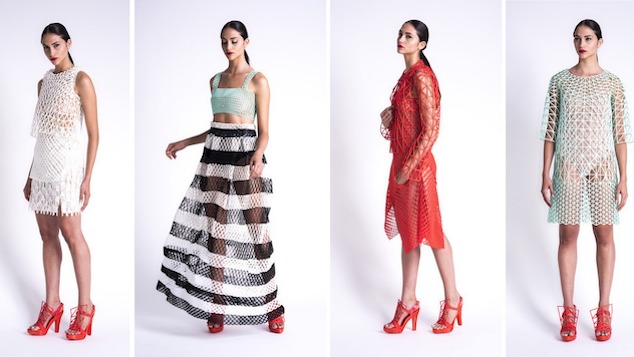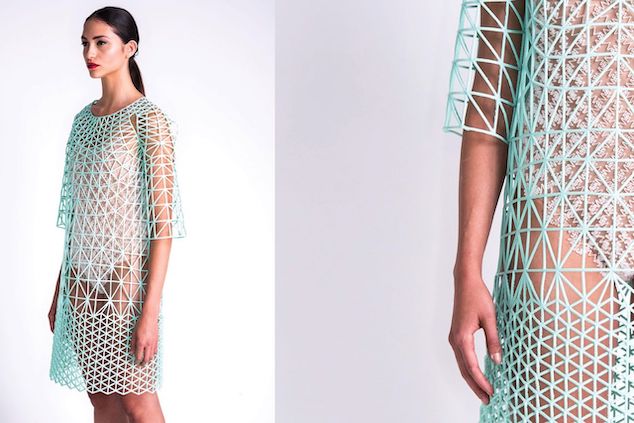
3D Printed Fashion: How to use 3D Printing to make better and more sustainable clothes & stop ongoing waste & ramp up for more efficient production.
One of the main issues impacting the sustainability of the fashion industry is overproduction. Every year, a lot of garments go in waste, not worn even once. Not just that, on average, the consumers end up throwing away 60 percent of their clothes every year resulting in a huge heap of landfill clog. So, who is to blame?
Well, the longer supply chain duration, along with low margins for manufacturers, create a dead-end for the garment industry that is left with just one choice – unnecessary mass production. And, the situation worsens knowing that the majority of these clothes cannot be recycled. With the usage of a lot of artificial materials and chemical dyes, these garments are hard to salvage.
The question is: Will 3D printing help produce better and more sustainable clothes? Here are some of the ways this technology offers a hand to the fashion industry in order to save the planet from the mess this chaos is pushing us to.
Putting Behind the Need for Global Sourcing
Today, designers and manufacturers compete with one another to become the best brand across their niche. To reach consumers around the world, they do not mind spending money and time on logistics. Because of longer durations the supply chain process endures, companies end up overproducing clothes that no one needs.
While the goal of becoming popular among consumers isn’t unreasonable, one cannot ignore the problems the environment has to face in return. Thankfully, 3D printing is there to help resolve the need for logistics to a great extent, if not completely.
To create clothes with 3D Printers, one requires a digital copy of the design, with proper print settings and quality. In such a scenario, designers do not need to ship the ready clothes produced in larger quantities to different locations. Only by sharing the 3D file, manufacturing units will be able to produce clothes as per the number in demand. In addition, the extra load put on the environment due to fuel emission during transportations will also cease drastically.
Say No to Mass Production
As discussed, mass production leads to overproduction. This, in turn, makes it even more difficult to manage garment waste. According to the World Economic Forum report, fashion waste is responsible for a global economic loss of $400 billion each year.
But is there a way we can stop producing in large numbers and fabricate the designs when needed? 3D printing, popular for on-demand production can become the trend changer while helping economies save billions spent on garment waste.
The fast production and easy access make 3D printing technology the best alternative for mass production in the coming years. Although the AM applications are very limited when it comes to the fashion industry, the impacts are under microscopes for years to further the development sooner.
Not only 3D Printers will allow manufacturers and shop owners to complete production when in demand, but the machine will also empower consumers wishing to print their clothes at home.
Learn More about the Best Commercial 3D Printers in the Market Right Now!
3D Printed Clothes are Easy to Recycle
The recycling of garment waste is a huge concern. The artificial materials and dyes used during the manufacturing process make it almost impossible to recover the clothes repeatedly for multiple uses. Most of the garments end up in landfills and never make it back to the outlets’ shelves. This certainly is a very serious problem that economies must solve with priority.
According to global reports, the fashion industry has doubled its production in the last 15 years. In addition, the consumers throw away the worn clothes sooner than before. Resulting in the fall of the time the clothes are worn before getting scrapped to 40 percent.
Among the waste generated every year, only around 12 percent goes for recycling and the rest are either burned or goes in the landfills. We haven’t covered the scarring party yet. The clothes collected for recycling are not always used for creating new garments. As a matter of fact, only 1 percent goes into the preparation of new clothing. The rest is scrapped for stuffing mattresses, or used in households for cleaning and similar purposes. In short, the vast majority of the clothes are never recycled.
With 3D printing, all these hassles can be overcome. As technology is advancing, experts are trying to find out sustainable and eco-friendly materials for printing clothes. The time is not far when we will have better solutions for creating garments using 3D printers made of organic materials. Hence, resolving the recycling issues exponentially.
Less Labor Intensive
As we know, 3D Printers are capable of turning complex designs into reality. And, the same applies to the fashion industry. Designers can create clothes incorporating patterns that aren’t possible otherwise. Hence, offering more room to experiment with textures, materials, as well as decorations.
And, all of these perks come in handy without investing too much in production. Not only 3D printers are one-time investments, but they also run on their own. Hence, eliminating the need for too many laborers needed for running traditional manufacturing units. Therefore, decreasing the overall cost for manufacturing clothes.
The Conclusion
Whenever we advance towards innovation, the first few attempts do not always seem promising. The same was the case with 3D printing, the technology that got its breakthrough in the 1980s. However, long after being neglected by corporate leaders, 3D printers stayed reserved mainly for rapid prototyping.
However, as it kept developing, bringing bigger possibilities into the picture, the industries sensed the capabilities of 3D printing within the mass market. And, this was no sooner than the late 2000s. Since then, there has been no stopping behind. With the help of this revolutionary technology, experts have been able to cater to various issues pertaining to the medical, construction, and other sectors. And, the need for reshaping the fashion industry isn’t hidden to anyone.
3D printing can fight many problems that may seem today an integral part of the clothing industry. The various perks will surely lead to a sustainable solution for garments’ production. The goal is still in its budding stage, however, sooner, things will take a sharp turn, bringing 3D Printers to the mainstream within the fashion sector.







